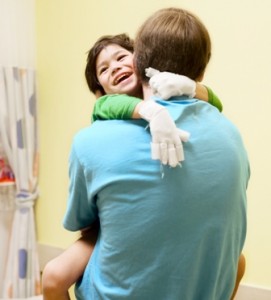Cerebral palsy affects thousands of children across the country, and each child will have his or her own unique challenges. Generally caused by damage to the brain during pregnancy, delivery, or shortly after birth, this disorder may limit some of the bodily functions of children that we normally take for granted.
Urinary incontinence is defined as the inability to control the act of urination. Also referred to as enuresis, this condition affects 1 in 4 children with cerebral palsy and can lead to other complications later in life. Incontinence in cerebral palsy is the direct result of poor muscle control caused by neurological or brain damage.
According to doctors, children need to be able to control their bladder by the age of 5. For children who are developmentally disabled, they should be able to do this by the cognitive age of 5.

Urinary Incontinence & Cerebral Palsy
There are various types of incontinence:
- Stress Incontinence – This occurs during normal activities such as sneezing, coughing or during exercise.
- Urge Incontinence – This normally occurs after strong urges to urinate, causing contraction of the bladder and involuntary urine loss.
- Overflow Incontinence – This occurs when the bladder can’t be completely emptied.
The bladder works in conjunction with specialized sphincter muscles to control the act of urination. However, problems with muscle tone means that children with cerebral palsy are often unable to control urine flow, leading to involuntary urination. It’s not uncommon for children with cerebral palsy to wet their beds on a regular basis. They may also have a slow leaking of urine throughout the course of the day or experience uncontrolled urination during school activities.
Seeing a Specialist Can Help
Children who suffer from incontinence as a result of cerebral palsy need to see an urologist so that they can get an in-depth evaluation to determine the extent of the problem. Before going to see an urologist, you may want to keep a 3-day journal detailing urine output, activities, foods, stressors and anything else you might consider to be helpful for a proper diagnosis.
Treatment for incontinence may include biofeedback training, special exercises, surgery, prescription drugs, as well as proper toilet posture. Additionally, involving a muscle re-education therapist can go a long way in helping the child relearn control and what to do to ensure that they can void their bladder to completion.
Children with cerebral palsy need to be treated with patience and love if they have urinary incontinence. This is because of the perceived stigma tied to both issues. With time, it’s possible to resolve or minimize this problem, enabling your child to live a healthy and productive life.

I am a one on one aide for a ten year old girl. She has recently started peeing her pants even after I have just taken her to the bathroom especially if she is laughing. She has not done this before. I am concerned her cerebralpalsy may be a contributor. Could that be possible?